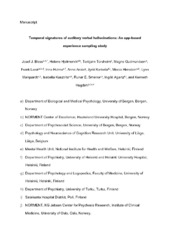| dc.contributor.author | Bless, Josef J | |
| dc.contributor.author | Hjelmervik, Helene | |
| dc.contributor.author | Torsheim, Torbjørn | |
| dc.contributor.author | Gudmundsen, Magne | |
| dc.contributor.author | Larøi, Frank | |
| dc.contributor.author | Holma, Irina | |
| dc.contributor.author | Arola, Anne | |
| dc.contributor.author | Korkeila, Jyrki | |
| dc.contributor.author | Hirnstein, Marco | |
| dc.contributor.author | Marquardt, Lynn Anne | |
| dc.contributor.author | Kusztrits, Isabella | |
| dc.contributor.author | Smelror, Runar | |
| dc.contributor.author | Agartz, Ingrid | |
| dc.contributor.author | Hugdahl, Kenneth | |
| dc.date.accessioned | 2020-04-23T08:56:36Z | |
| dc.date.available | 2020-04-23T08:56:36Z | |
| dc.date.issued | 2020 | |
| dc.Published | Bless JJ, Hjelmervik HS, Torsheim T, Gudmundsen M, Larøi F, Holma I, Arola A, Korkeila J, Hirnstein M, Marquardt LA, Kusztrits I, Smelror R, Agartz I, Hugdahl K. Temporal Signatures of Auditory Verbal Hallucinations: An App-Based Experience Sampling Study. Schizophrenia Research. 2020;215:442-444 | eng |
| dc.identifier.issn | 0920-9964 | |
| dc.identifier.issn | 1573-2509 | |
| dc.identifier.uri | https://hdl.handle.net/1956/21981 | |
| dc.description.abstract | The assessment of auditory verbal hallucinations (AVHs) has traditionally been conducted through (semi-)structured interviews, such as the Positive and Negative Syndrome Scales (PANSS; Kay et al., 1987) and the Psychotic Symptom Rating Scales (Haddock et al., 1999) in patients and the Launay Slade Hallucination Scale (Launay and Slade, 1981; Larøi and Van der Linden, 2005) in the general population. However, since standard assessments rely on retrospective and summative reports and thus on the person's accurate memory and capability to estimate the average experience of past hallucination episodes (usually a summary of the last week), the extent to which AVHs are stable or vary across the course of hours or days is currently unknown. To fill this knowledge gap, the current study used an in-house developed mobile application (app) to capture AVHs as experienced in the moment in which they occur. This approach has recently been termed “digital phenotyping” (Insel, 2017; Torous and Keshavan, 2018). The aim of the present study was to explore the relationships between five key AVH-dimensions (cognitive control, emotional content, spatial localization, intensity, and severity) and for the first time, the temporal patterns of these dimensions. | en_US |
| dc.language.iso | eng | eng |
| dc.publisher | Elsevier | eng |
| dc.rights | Attribution CC BY-NC-ND | eng |
| dc.rights.uri | http://creativecommons.org/licenses/by-nc-nd/4.0/ | eng |
| dc.title | Temporal Signatures of Auditory Verbal Hallucinations: An App-Based Experience Sampling Study | eng |
| dc.type | Peer reviewed | |
| dc.type | Journal article | |
| dc.date.updated | 2020-02-03T12:25:49Z | |
| dc.description.version | acceptedVersion | |
| dc.rights.holder | Copyright 2019 Elsevier | eng |
| dc.identifier.doi | https://doi.org/10.1016/j.schres.2019.11.020 | |
| dc.identifier.cristin | 1762991 | |
| dc.source.journal | Schizophrenia Research | |
| dc.source.pagenumber | 442-444 | |
| dc.identifier.citation | Schizophrenia Research. 2020;215:442-444 | |
| dc.source.volume | 215 | |

